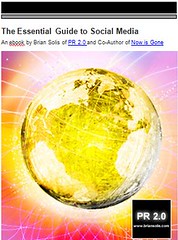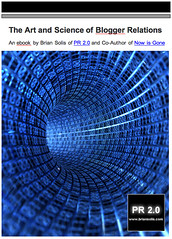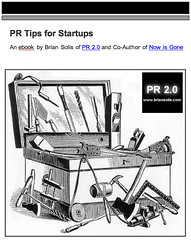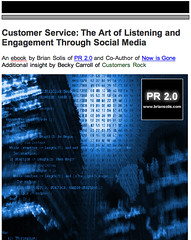Ladies and Gentlemen, The Conversation Has Left The Building

Earlier this year, I wrote “The Value of Online Conversations,” to share and talk through my thoughts related to improving the quality of online discussions in the face of potential degradation and decentralization of important online discussions.
We live in the era of Social Media, which represents the socialization of content and conversations as well as the creation of communities around thoughts and ideas. People are the hubs of information and we’re witnessing the creation of mini-societies that expand, contract, and connect online and offline. This new paradigm for discovering, distributing and forging relationships based on thought leadership is inspiring and defining significant social and technological progression as well as conversational frameworks.
As Social Media evolves, the value of online conversations is becoming distributed and decentralized. As the host of any given conversation, it is almost impossible to expect your community to discover or congregate around your content in any one given place, especially the point of origin. It’s both the challenge and the promise of micromedia and social networks. The comments section of your blog, for example may not truly represent the community response or reaction because it may thrive across other disparate networks and communities, whether you’re aware of it or not.
And concurrently, those conversations that matter to you, from both a learning and sharing perspective, span a vast array of networks where you’re already participating as well as the networks you may not know exist.
Conversations might have thrived in comments for several years, but those conversations are also augmenting and migrating through thriving micromedia and active social networks. However, it's important to note and also to remember, that conversations aren't necessarily limited to comments either. Blog posts that are inspired by thoughts shared in other posts also contribute to and extend conversations and they only increasing in volume and frequency - regardless of whether the platform is traditional (such as WordPress or Blogger) or published on the emerging category of microblogs and micro media (such as Twitter, Jaiku, Utterz, Seesmic, Pownce, etc.)

Dan Farber of CNET recently discussed the importance of the blogosphere and its ability to help conversations evolve. He observed, "Moving the conversation forward is what the blogosphere does best. It starts with an original thought or angle, a scoop of perception, and others add their own perspectives and discoveries to the data pool. You end up with a rich "web" of information and links about a particular item."
Sarah Perez recently tackled the subject on ReadWriteWeb, where she observed that conversations are only increasing in volume and frequency, “The truth of the matter is, like it or not, the conversations that once existed solely in the blogosphere have now moved on. People still comment, but in a lot of cases, those comments aren't on found on the blog itself. So the question is, has the conversation become diluted among all the different services and applications? Or is it just adding layers to the original topic?”
Sarah also spotlights tools and shares tips to stay connected to the conversations that matter to you.
Indeed, conversations are no longer relegated to blogs. Nor are they limited to any one community. Twitter, FriendFeed, Facebook, et al, are not only online neighborhoods (or trendy tools), but they are also forums where your contacts may choose to share their reaction and thoughts directly with you instead of immortalizing those thoughts in the comments section of your blog. Conversations are not only adding layers to the original topic, they’re also more visible and influential than ever before.
After publishing my last several posts, I’ve noticed that a majority of feedback poured in at Twitter and Facebook, which complemented the blog, but also distributed the conversation nonetheless.
Is this a bad thing?
No. It’s just a reminder, that whether you’re a content producer or reacting to the thoughts of someone else, that all feedback accumulates into a repository of collected thought leadership, or lack thereof.
Since the best conversationalists are also the best listeners, the evolution of participatory media requires you to focus your attention across multiple networks in order to invest in the conversations that have value to you.
The investment isn’t inexpensive either. It requires your expertise, time, and attention. All this at a time, when many are already suffering from Social Network Fatigue. By not participating, you’re intentionally withdrawing your brand (or your company’s) brand from the conversation and creating an opportunity for your competition to steal the attention. Your community of strategic contacts is reflective of what you put into it. Since it’s an investment, you earn the relationships and the value that you deserve.
This requires focus and value-add. It requires participation. It doesn’t promote or encourage the practice of lobbing ideas over network walls with the hopes people will find it, discuss it, and promote it. Although the “online you” is distributed, it should also be concerted. The investment in value-added, distributed participation elevates your expertise, grows your online brand and contributes to your overall social capital, but it’s not easy.
Loic Le Meur, founder of video conversational community Seesmic, sparked a “distributed” series of online conversations. He charted his social map and made a noteworthy case to re-centralize content and conversations, in his case, back to his blog.

We used to have our social online presence very centralized, for me it was my blog. The current trend is very interesting, everything is decentralized and we only use the best services by type of media (text, photos, video, music, events etc). Everything we post is totally decentralized this is why tools like Mybloglog, Friendfeed and Socialthing start to gather all of these for us and it is a great idea.
The challenge for Friendfeed and the like is that while I really like all my services gathered in one place, I would rather that these would be centralized on my blog instead of a third party service.
It’s not an unreasonable request, and would in fact, inject a level of sanity, control, and management back into the equation of creating socialized content, but as Stowe Boyd puts it, “I think that day is done.”
Stowe continues:
Basically, conversation is moving from a very static and slow form of conversation — the comments thread on blog posts — to a more dynamic and fast form of conversation: into the flow in Twitter, Friendfeed, and others. I think this directionality may be like a law of the universe: conversation moves to where is is most social. Personally, I don’t think the genie can be put back in the bottle.
The truth is that we are embracing new tools because they’re are either intriguing and fascinating to us and/or because those within our social graph are also adopting them to stay connected and participate in distributed online conversations.
We are responsible for the decentralization of our content and our attention. We need to embrace it focus.
I created a Social Map that outlines where I create, discover, collaborate, and socialize and it serves as a stark reminder that I am distributed and there’s no turning back - at least not yet.

I participate in the communities where I find value and where I can in turn contribute to the value. It is distributed. It is decentralized. However, it is this way because each community sustains its own unique culture, a culture that is only partially represented through the latest crop of aggregators and activity hubs such as FriendFeed, SocialThing, and Ping.fm.
Michael Arrington of TechCrunch also introduced the notion of Data Portability into the mix and it does open up some interesting possibilities for helpful solutions.
Data Portability may turn out to be the answer that people are looking for. And it may turn out to be a sort of anti-FeedFriend. The whole point of Data Portability is to get social networks talking to each other and exchanging user data, with their explicit permission. Want to add your flickr photos, twitter messages and YouTube Videos to your blog? Data Portability is working to help make that happen through consensus driven policies and procedures. In essence, data portability embraces the Decentralized Me, but lets users re-centralize it wherever they please.
I embrace and invest my attention in those communities that offer a return. It isn’t much more scalable as it is and I may adopt new tools to help me participate through an aggregated fashion if I can do so without losing the context of the conversation stream and the overall culture.
I am but one person. Businesses, on the other hand, have an opportunity to scale with the conversations that represent the ability to deliver value to each respective community as well as its bottom line.
The reward for participating and adding value to these conversations is Social Capital. The penalty for self-promotion, one-sided conversations, or lack of genuine participation is evident in the lack of apparent ROI as well as the lack of respect you’re granted.
The centralization of the decentralized me starts with identifying the communities of value instead of merely trend surfing. Cultivate relationships where those relationships benefit from your participation, which in turn, ultimately help you. Creating a complex social map isn’t the end-game. Creating a social map that outlines the distributed conversations that impact you or your brand is the goal. Identifying these opportunities and observing the cultures of each community will help you determine the resources and time investment required.
The best conversationalists are also the best listeners. Conversations are distributed and the tools for finding them are available and increase in functionality every week. It requires a proactive approach to find them, for they may not necessarily find you.
Recommended Reading:
Gary Vaynerchuk Puts the Social in Social Media
The Art of Listening and Engagement
The Social Media Manifesto
Conversational Marketing
Facebook is the Hub for Your Personal Brand
twitter micriomedia conversation brand blogosphere comments community socialmedia social media 2.0 media2.0 media+2.0 social+media conversational marketing brian+solis branding communications customer+service listening seesmic techcrunch stowe+boyd social+network facebook friendfeed blog blogger microblog blogging












6 Comments:
I'm willing to bet this post gets discussed on Twitter, FriendFeed, in a variety of other blogs, but as you say, not here in the comments.
I feel I owe it to the author to comment here first, then elsewhere if I'm so inclined. When the conversation only takes place on other venues, it's not social.
You've made some good points that I might want to expand on in my blog, but I break the conversational chain if I only reply there and not here.
It is going to be a challenge to aggregate all our web presence into one interface. There are some early attempts, but at the moment they all fall short in one aspect or another. There is a plugin for Word Press that will make Twitter feeds of my posts and posts of my Twitter comments, but that only addresses the one service.
The speed at which developments take place on the internet make us impatient. It may take some time for someone to develop the killer application we all need.
Excellent article. I made a map much like this months ago and will post it also.
http://TheSocialNetworker.com
I just received your book by the way
Brian,
Great post topic. I have definitely seen the dilution of comments and conversation through various social media channels. I myself have even been propagating this. After I read your post I twittered it, and then realized that I should actually comment on your page!
I think another interesting topic would be how the off line interactions influence the online conversations.
Great stuff Brian,
Jacob
Great topic Brian.
I have been finding this "distributed conversation" to be a fact for me for a while now. It's great to see comments pile up on a post, but when I remind myself that a reaction on Twitter is still a comment, I remind myself that the conversation is taking off.
Then it;s just a matter of keeping track.
another example is my use of Utterz. Utterz goes through Twitter (much of the time) and my blog (fairly frequently). On the blog posts, you can see how many replies I have on Utterz.com that are not in the blog post's own thread, which is kind of interesting.
"The best conversationalists are also the best listeners."
This is a hard one for me. I tend to interrupt in a conversation because my brain is already formulating my response.
However, when using applications such as IM and Google Chat I am forced to "listen" to the entire response and I like that. It's good training for real life :)
Hi Brian,
An excellent observation into the decentralisation trend that's happening.
i sort of usually want to hold on to where my publishing starts from, and i try to make my blog at least a central gathering point of everything else i do online. (my lifestream if you may)
but perhaps you are right, i think there are so many places you can publish, and it may be humanly impossible to centralise all that information.
Blogging is evolving, i find some inspiration from this blogger over here, at how he has used an effective design to bring his lifestream together onto one web entity. (www.yongfook.com)
being able to listen in to the nuggets from the overload of information and publishing so that it gets on effective web channels, is definitely the new media literacy skill that practitioners need now.
- brian
Post a Comment
<< Home